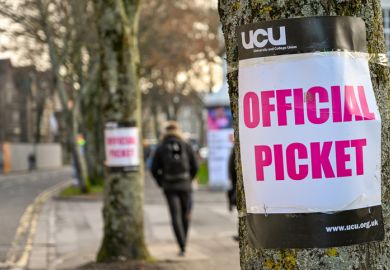Some UK universities rely on casual, hourly paid staff to do as much as half of all their teaching, new analysis suggests.
The University and College Union sent Freedom of Information requests to 135 higher education institutions, asking them to provide the number of hours of scheduled learning and teaching activities delivered during the academic year 2015-16. Universities were then asked to state the number of those hours that had been delivered by hourly paid lecturing staff.
Just 38 institutions returned usable information, but with caveats about its accuracy. Based on these data, the union estimates that most universities use hourly paid teachers for between 15 and 40 per cent of their teaching, with an average of 27 per cent.
The UCU then compared the data with existing estimates in the sector. By this method of calculation, the UCU estimates that most universities probably rely on hourly paid staff to deliver about 25 per cent of their undergraduate teaching, with some pre-92 universities likely to use hourly paid staff for up to 50 per cent.
However, the true scale is impossible to quantify, according to the union, as 96 universities did not complete the request. Thirty-six ignored it, and 60 said either that they did not hold the full information or that it would take too long to obtain it.
Jonathan White, bargaining policy and negotiations official for the UCU, said the union decided to conduct the analysis after the Higher Education Statistics Agency released data that put the number of atypical contracts at 3 per cent of the full-time equivalent of the academic workforce.
“There are all kinds of problems [with this figure] because you’re only measuring part of the hourly paid teaching population,” he said. For one thing, he explained, “you can’t compare people who are hired and paid for a handful of hours of teaching as though they are particles of a full-time lecturer”.
He continued: “We’re not saying [ours] is a definitive picture of what’s going on. We’re trying to start a more intelligent conversation about the role of hourly paid staff in delivering front-line teaching in universities.
“And the fact is that universities have swept this issue under the carpet, partly by allowing their national representatives to peddle this absurd figure around and partly by failing – or refusing – to disclose data.”
According to the union, staff on insecure contracts face day-to-day problems such as not having access to basic facilities, not being included in curriculum design and review, and not being paid for preparation and assessment, as well as the long-term stresses of financial hardship and lack of job security.
The union is now calling on the newly created Office for Students to compel universities to reveal full details of their use of hourly paid staff.
A spokesman for the Universities and Colleges Employers Association said that, together with higher education trade unions, they had come up with a set of proposals to improve data on the hourly paid and casual workforce.
“These proposals have all been agreed and adopted and have resulted in changes to the Hesa staff record in 2017-18,” he said. “We look forward to being able to see the first analysis of this improved data when Hesa publishes it. It is therefore disappointing that UCU’s latest ‘report’ tries to collect data from individual HE institutions in a different way.”
The spokesman added: "The quality of very many degree programmes at HE institutions today is frequently enhanced by input from skilled professionals from outside the sector contributing specialist teaching on specific courses. Such input is hugely valued by students and is often essential for the programme’s accreditation. Hourly-paid teaching and tutoring also provide important developmental opportunities for postgraduates, particularly for those interested in a future career in the sector.
“Ucea has not engaged in ‘obfuscation’ by reporting on the Hesa data for atypical contracts in 2015-16 to show that these contracts represent 3 per cent of the full-time equivalent of the academic workforce. Ucea undertook this analysis in response to UCU’s misuse of these figures to claim that over 50 per cent of the teaching workforce was on an insecure contract. UCU’s use of these data drew comment from Hesa, the official statistics agency for the HE sector. Despite Hesa’s public clarification on the data, it is disappointing that UCU continues to repeat its analysis in its latest report."
Register to continue
Why register?
- Registration is free and only takes a moment
- Once registered, you can read 3 articles a month
- Sign up for our newsletter
Subscribe
Or subscribe for unlimited access to:
- Unlimited access to news, views, insights & reviews
- Digital editions
- Digital access to THE’s university and college rankings analysis
Already registered or a current subscriber?








